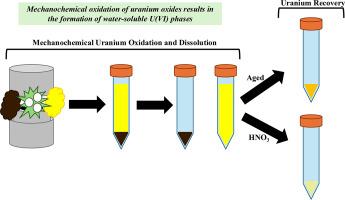Mechanochemical oxidation and dissolution of uranium oxide phases: Implications for nuclear material processing
IF 3.2
2区 工程技术
Q3 MATERIALS SCIENCE, MULTIDISCIPLINARY
引用次数: 0
Abstract
Mechanochemical synthetic methods are often highlighted as efficient, low-waste, and low-temperature processes, and they could improve the sustainability of current spent nuclear fuel recycling methods. In the present study, we offer an in-depth analysis of the mechanochemical oxidations of UO2 and U3O8 with Na2O2/H2O2 and Na2CO3/H2O2 for use in spent nuclear fuel recycling schemes. Solid-state and solution characterization of the mechanochemical products indicates the formation of water-soluble U(VI) triperoxide and peroxocarbonate products in >85 % yields. We show that uranium can be recovered from the resulting aqueous solutions of the mechanochemical triperoxide and peroxocarbonate products via aging or acidification to form uranyl oxyhydroxide or uranyl peroxide hydrates. An evaluation of the efficiency of the milling experiments shows that the oxidation reactions are enhanced by mechanical processing but may not be mechanically driven. Addition of select fission analogues suggests that fission product partitioning will be similar to that reported for the CARBEX process.

铀氧化物相的机械化学氧化和溶解:对核材料加工的影响
机械化学合成方法经常被强调为高效、低废物和低温的过程,它们可以提高现有乏核燃料回收方法的可持续性。在本研究中,我们深入分析了UO2和U3O8与Na2O2/H2O2和Na2CO3/H2O2的机械化学氧化,用于乏核燃料回收方案。机械化学产物的固态和溶液表征表明,在85%的收率下形成了水溶性的三过氧化物和过氧化物产物。我们表明,铀可以通过老化或酸化从机械化学三过氧化物和过碳酸盐岩产物的水溶液中回收,形成氢氧铀酰或过氧铀酰水合物。对铣削实验效率的评价表明,机械加工可以增强氧化反应,但可能不是机械驱动的。添加选择的裂变类似物表明,裂变产物的划分将类似于CARBEX过程的报告。
本文章由计算机程序翻译,如有差异,请以英文原文为准。
求助全文
约1分钟内获得全文
求助全文
来源期刊

Journal of Nuclear Materials
工程技术-材料科学:综合
CiteScore
5.70
自引率
25.80%
发文量
601
审稿时长
63 days
期刊介绍:
The Journal of Nuclear Materials publishes high quality papers in materials research for nuclear applications, primarily fission reactors, fusion reactors, and similar environments including radiation areas of charged particle accelerators. Both original research and critical review papers covering experimental, theoretical, and computational aspects of either fundamental or applied nature are welcome.
The breadth of the field is such that a wide range of processes and properties in the field of materials science and engineering is of interest to the readership, spanning atom-scale processes, microstructures, thermodynamics, mechanical properties, physical properties, and corrosion, for example.
Topics covered by JNM
Fission reactor materials, including fuels, cladding, core structures, pressure vessels, coolant interactions with materials, moderator and control components, fission product behavior.
Materials aspects of the entire fuel cycle.
Materials aspects of the actinides and their compounds.
Performance of nuclear waste materials; materials aspects of the immobilization of wastes.
Fusion reactor materials, including first walls, blankets, insulators and magnets.
Neutron and charged particle radiation effects in materials, including defects, transmutations, microstructures, phase changes and macroscopic properties.
Interaction of plasmas, ion beams, electron beams and electromagnetic radiation with materials relevant to nuclear systems.
 求助内容:
求助内容: 应助结果提醒方式:
应助结果提醒方式:


